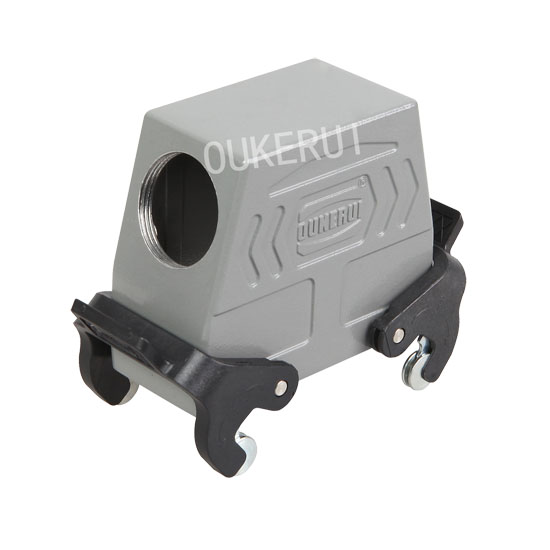Knowledge About Heavy Duty Connector Hoods
2024-06-25
Heavy-duty connector hoods are critical components designed to protect and secure the connection points of heavy-duty connectors in industrial applications. They play a crucial role in ensuring the durability and reliability of electrical connections by providing robust protection against environmental and mechanical stresses. Here’s an in-depth look at heavy-duty connector hoods:

Overview
Heavy-duty connector hoods cover and protect the connector inserts and contacts. They are typically constructed from durable materials and are designed to withstand harsh industrial environments. These hoods are essential for maintaining the integrity and performance of electrical connections.
Key Components
1. Body: The main protective shell of the hood, often made from materials like aluminum, stainless steel, or reinforced plastic.
2. Gasket: Provides a seal between the hood and the base or mating part to ensure ingress protection (e.g., against dust and moisture).
3. Cable Entry: Openings through which cables are routed into the connector. These may include strain reliefs or glands to secure and protect the cables.
4. Locking Mechanism: Ensures that the hood securely fastens to the base or mating connector, often involving latches, screws, or clips.
Types of Heavy-Duty Connector Hoods
1. Top Entry Hoods: Cable entry is from the top. Suitable for applications where space above the connector is available.
2. Side Entry Hoods: Cable entry is from the side. Ideal for applications with limited vertical space.
3. Angled Entry Hoods: Cable entry is at an angle, providing flexibility in cable routing and management.
4. Double Lever Hoods: Feature two levers for additional security and a tighter seal, commonly used in applications requiring high mechanical stability.
Specifications
1. Material: Aluminum, zinc die-cast, polyamide, or thermoplastic, chosen based on the required mechanical strength and environmental resistance.
2. Ingress Protection (IP) Rating: Defines the level of protection against dust and water. Common ratings include IP65, IP67, and IP69K.
3. Temperature Range: Operating temperature range, typically from -40°C to +125°C or higher.
4. Chemical Resistance: Ability to withstand exposure to oils, solvents, and other chemicals.
5. Flame Retardancy: Compliance with fire safety standards for specific industrial applications.
Selection Criteria
1. Environmental Conditions: Assess the level of protection needed against dust, water, and chemicals.
2. Mechanical Requirements: Consider the robustness needed to withstand mechanical stress, impacts, and vibrations.
3. Cable Management: Determine the best entry type (top, side, or angled) for efficient cable routing and space utilization.
4. Compatibility: Ensure the hood is compatible with the selected inserts and mating bases or connectors.
5. Compliance: Verify that the hood meets relevant industry standards and certifications (e.g., IEC, UL).
Applications
1. Industrial Automation: Protecting connections in factory automation systems.
2. Transportation: Ensuring reliable connections in vehicles, trains, and aircraft.
3. Energy Sector: Used in power generation and distribution, including renewable energy systems.
4. Heavy Machinery: Securing connections in construction and agricultural equipment.
5. Robotics: Providing protection for connections in robotic systems and automated equipment.
Installation and Maintenance
- Proper Sealing: Ensure gaskets are correctly positioned to maintain the IP rating.
- Secure Fastening: Use the appropriate locking mechanism to prevent accidental disconnection.
- Periodic Inspection: Regularly check for signs of wear, corrosion, or damage.
- Cleaning: Keep hoods clean to prevent contamination that could compromise the seal.
- Replacement: Replace damaged or worn-out hoods to maintain protection levels.
Leading Manufacturers
- Harting
- TE Connectivity
- Weidmüller
- Molex
- Phoenix Contact
These manufacturers offer a wide range of heavy-duty connector hoods designed to meet diverse industrial needs and standards.
Conclusion
Heavy-duty connector hoods are essential for protecting and securing electrical connections in industrial environments. By understanding their types, specifications, and selection criteria, you can ensure the optimal performance and longevity of your electrical systems. Proper installation and regular maintenance further enhance their reliability and effectiveness.


